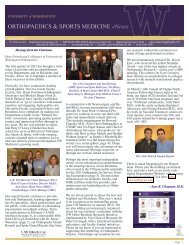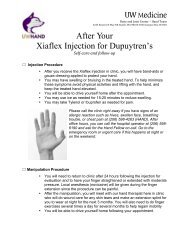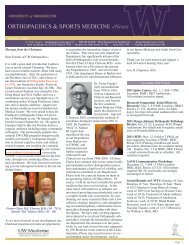2002 - University of Washington Bone and Joint Sources
2002 - University of Washington Bone and Joint Sources
2002 - University of Washington Bone and Joint Sources
Create successful ePaper yourself
Turn your PDF publications into a flip-book with our unique Google optimized e-Paper software.
Less is More: Building Bigger <strong>Bone</strong>s With Less Exercise<br />
SUNDAR SRINIVASAN, PH.D., DAVID A. WEIMER, STEVEN C. AGANS, STEVEN D. BAIN,<br />
AND TED S. GROSS, PH.D.<br />
Deficient bone mass in the<br />
elderly arises due to<br />
degradation <strong>of</strong> the normal<br />
balance between bone resorption (i.e.,<br />
removal) <strong>and</strong> bone formation(i.e., new<br />
bone growth) typical in the young<br />
adult. Current pharmaceutical<br />
strategies to counteract bone loss are<br />
highly successful in blocking the<br />
elevated resorption associated with<br />
menopause. However, options for<br />
enhancing bone formation as a means<br />
<strong>of</strong> increasing bone mass are extremely<br />
limited. Given our rapidly aging<br />
population, the current inability to<br />
safely <strong>and</strong> effectively build bone mass<br />
consigns millions to a fate <strong>of</strong> elevated<br />
fracture risk for a substantial portion<br />
their lives.<br />
Exercise represents one <strong>of</strong> the few<br />
potential means <strong>of</strong> building bone mass.<br />
To date, however, exercise regimens<br />
have proven only minimally successful<br />
in building bone mass. The elderly, in<br />
particular, are unable to consistently<br />
comply with the high-impact,<br />
strenuous loading events (such as<br />
jumping <strong>and</strong> vigorous running)<br />
typically associated with even minimal<br />
bone accretion. One objective <strong>of</strong> our<br />
group has been to develop low<br />
magnitude loading regimens that are<br />
highly stimulatory for bone formation.<br />
Based on data from our group <strong>and</strong><br />
others, it appears that fluid flow within<br />
the tissue underlies bone<br />
mechanotransduction. We therefore<br />
hypothesized that inserting a nonloaded<br />
rest pause between each loading<br />
cycle (which would increase fluid flow<br />
within bone) would enhance the<br />
osteogenic potential <strong>of</strong> a low<br />
magnitude, locomotion-like<br />
mechanical loading regimen. To<br />
examine this hypothesis, we contrasted<br />
the ability <strong>of</strong> low magnitude loading<br />
regimens with <strong>and</strong> without a 10-s rest<br />
interval inserted between each load<br />
cycle to induce bone formation.<br />
METHODS<br />
Eighteen adolescent female C57Bl/<br />
6J mice (10 wk) underwent external<br />
loading <strong>of</strong> the right tibia using the noninvasive<br />
murine tibia loading device.<br />
Mice were r<strong>and</strong>omly assigned to three<br />
groups: 1) low magnitude (low; n=6),<br />
2) low magnitude, rest-inserted (restinserted,<br />
n=6), <strong>and</strong> 3) high magnitude<br />
(high, n=6). The low magnitude group<br />
underwent 100 cycle/d <strong>of</strong> a 0.25 N peak<br />
load, 1 Hz, 0.01/s strain rate trapezoidal<br />
waveform for 5 consecutive days<br />
(roughly equivalent to walking). The<br />
(A)<br />
(B)<br />
(C)<br />
Figure 1: Composite fluorescent<br />
micrographs <strong>of</strong> the mouse mid-shaft<br />
illustrate minimal periosteal bone<br />
formation in response to the low<br />
magnitude regimen (A), <strong>and</strong> substantial<br />
periosteal bone formation stimulated by<br />
the high magnitude (B) <strong>and</strong> rest-inserted<br />
regimens (C, arrows). Endocortical<br />
labeling was similar for each group <strong>and</strong><br />
no different than that observed in intact,<br />
contralateral tibia.<br />
low magnitude rest-inserted group<br />
underwent a 10 cycle/d regime with a<br />
10 s pause inserted between each load<br />
cycle. Peak load <strong>and</strong> peak strain rate<br />
were equivalent to the low magnitude<br />
group. The high magnitude group<br />
underwent a 100 cycle/d, 1 Hz regime<br />
with the peak load <strong>and</strong> strain rate<br />
doubled compared to the low<br />
magnitude group (roughly equivalent<br />
to vigorous running). The overall daily<br />
external loading period for the mice in<br />
all groups was therefore 100 s. All<br />
animals were allowed 23 d <strong>of</strong> additional<br />
cage activity following the 5 day loading<br />
regimen to facilitate consolidation <strong>of</strong><br />
new bone. <strong>Bone</strong> formation was<br />
assessed via dynamic<br />
histomorphometry.<br />
RESULTS<br />
Consistent with normal long bone<br />
growth, the young mice examined in<br />
this study exhibited active osteoblast<br />
activity on both endocortical <strong>and</strong><br />
periosteal surfaces at the initiation <strong>of</strong><br />
the study. Periosteal bone formation<br />
rate was significantly elevated by both<br />
high magnitude (p=0.01; 3.7-fold vs<br />
paired contralateral tibia) <strong>and</strong> restinserted<br />
loading (p=0.01; 2.3-fold vs<br />
paired contralateral tibia; Figures 1, 2).<br />
While high magnitude <strong>and</strong> restinserted<br />
loading were more stimulatory<br />
for osteoblasts than low magnitude<br />
loading, no statistical differences were<br />
observed between high magnitude <strong>and</strong><br />
rest-inserted loading with any assessed<br />
bone formation parameter. As<br />
compared to intact bones, both high<br />
magnitude (p=0.05) <strong>and</strong> rest-inserted<br />
(p=0.03) loading induced small, but<br />
significant increases in cortical area (5.1<br />
<strong>and</strong> 6.2%, respectively).<br />
DISCUSSION<br />
Using the non-invasive murine tibia<br />
loading model, we found that low<br />
magnitude, rest-inserted loading<br />
significantly enhanced periosteal bone<br />
formation in growing mice.<br />
Surprisingly, the bone formation<br />
elicited by 10 cycles <strong>of</strong> rest-inserted<br />
loading was statistically comparable to<br />
that induced by a st<strong>and</strong>ard locomotionlike<br />
waveform 10-fold greater in cycle<br />
38 <strong>2002</strong> ORTHOPAEDIC RESEARCH REPORT















